Eurasian Lynx
Lynx lynx
Eurasian lynxes can survive extreme weather up to elevations of 18,000 feet
Advertisement
Eurasian Lynx Scientific Classification
- Kingdom
- Animalia
- Phylum
- Chordata
- Class
- Mammalia
- Order
- Carnivora
- Family
- Felidae
- Genus
- Lynx
- Scientific Name
- Lynx lynx
Read our Complete Guide to Classification of Animals.
Eurasian Lynx Conservation Status
Eurasian Lynx Facts
- Prey
- Deer, elk, hare, rabbits, foxes, birds, and rodents
- Name Of Young
- Kittens
- Group Behavior
- Solitary
- Fun Fact
- Eurasian lynxes can survive extreme weather up to elevations of 18,000 feet
- Biggest Threat
- Habitat loss and poaching
- Most Distinctive Feature
- The thick fur, bobbed tail, and ear tufts
- Other Name(s)
- Northern lynx
- Gestation Period
- 70 days
- Litter Size
- one to five kittens
- Habitat
- Forests and mountains
- Diet
- Carnivore
- Type
- mammal
- Common Name
- Eurasian Lynx
- Number Of Species
- 1
- Location
- Eurasia
View all of the Eurasian Lynx images!
“The Eurasian lynx is an elusive cat that thrives in extreme, hostile conditions.”
Sporting distinctive ear tufts and long cheek hairs, this animal is an extraordinarily effective hunter thanks to its incredible power and speed. They need so much space to hunt and mate, however, that they rarely live around humans. The remote mountains and forests of Eurasia are their main home. This article will cover some interesting facts about the identification, diet, and habitat of the Eurasian lynx.
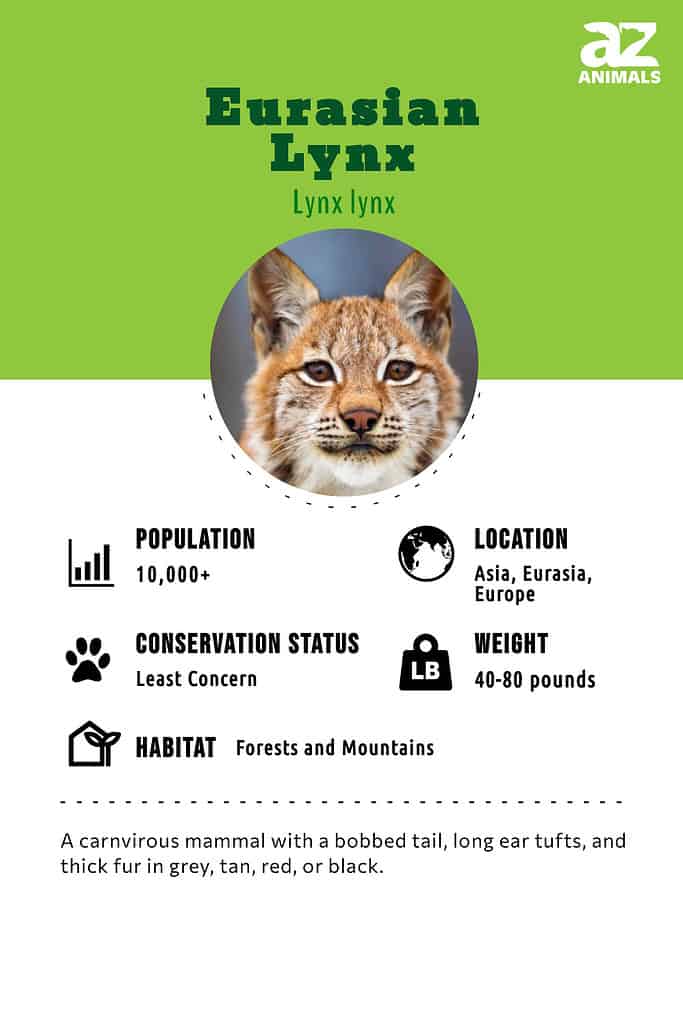
3 Incredible Eurasian Lynx Facts!
- The top speed of the Eurasian lynx isn’t entirely known, but if it’s anything like the bobcat, then it may be able to reach speeds in excess of 30 miles per hour in short bursts.
- In places where human hunters aren’t present, the Eurasian lynx plays a role in controlling deer and goat populations. They can kill anywhere between 10% and 40% of all roe deer, red deer, and chamois per year.
- Because of their soft fur, they were nearly hunted to extinction in some places, particularly Europe.
Scientific Name

Eurasian lynx are carnivores with thick fur and bobbed tails.
©Alexandra Giese/Shutterstock.com
The scientific name of the Eurasian lynx is Lynx lynx; both the genus and species share the same scientific name. Lynx is a common word in many European languages. It’s thought to mean light or brightness. This refers to the animal’s glowing eyes and ability to see in the dark. The Eurasian lynx is closely related to the Canadian lynx, Iberian lynx, and bobcat in the same genus.
Evolution and Origins
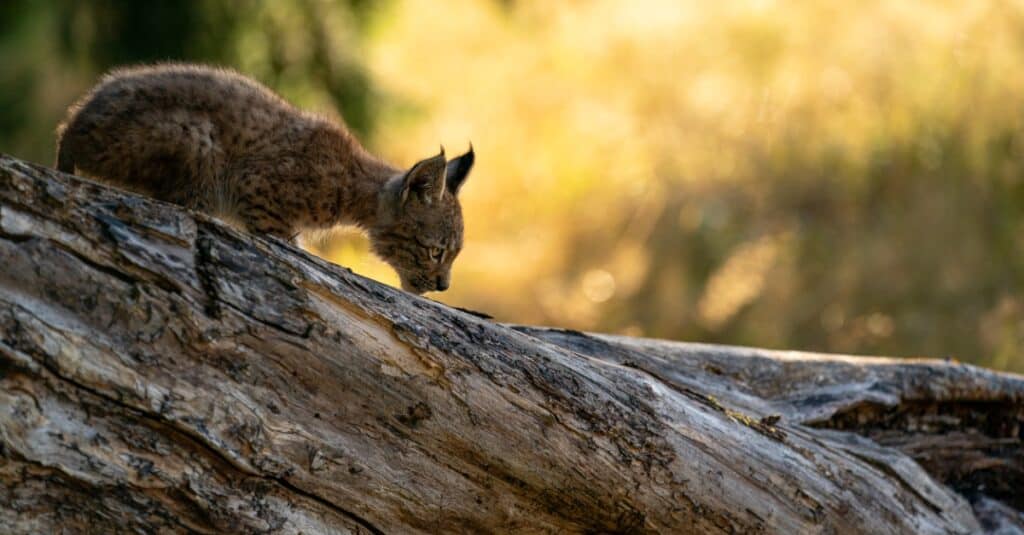
Eurasian lynx have been around for millions of years.
©iStock.com/sduben
The Eurasian lynx, also known as the Siberian or European lynx, has a rich evolutionary history dating back to the Pleistocene era. Fossil records show that these majestic felines have been roaming the earth for over 2 million years and have undergone significant changes throughout their evolution.
One of the earliest ancestors of the Eurasian lynx was Felis lunensis, which lived in Europe during the early Pleistocene period. Over time, this species evolved into Lynx issiodorensis, which inhabited both Europe and Asia around 1 million years ago. This prehistoric cat had characteristics similar to modern-day lynxes but was larger in size and had longer legs.
During the middle Pleistocene period (around 500,000-125,000 years ago), Lynx spelaea emerged as one of the dominant species of Eurasian lynxes. Known as “cave lions,” these animals were massive compared to their modern counterparts – some males weighed up to 300 pounds! Despite their size, they were agile hunters and preyed on large herbivores like bison and mammoths.
Today’s Eurasian lynxes are believed to have descended from Lynx pardinus (Iberian Lynx) and migrated eastward towards Asia during glacial periods when land bridges connected continents. These cats adapted well to various habitats ranging from temperate forests to arid deserts. They are still found throughout much of Europe today.
Appearance

The Eurasian lynx looks a lot like a domesticated cat but much larger.
©iStock.com/Korbinian Mueller
The Eurasian lynx looks very much like a typical cat, but it has some unique features and adaptations that stand out from the others. It is characterized most of all by exceptionally thick fur that varies in colors between gray, rusty red, and yellow. Spotted, striped, and solid patterns are all common variations and appear throughout the lynx’s entire range.
The tail is short and bobbed with a black tip. The round face has large, triangular ears with black tufts at the end. The big, thick paw pads are special adaptations for traveling on the snow. Measuring up to four feet long and nearly three feet in height, it is the largest of all four lynx species but also among the smallest of the “big” cats.
Identification of the sexes can be difficult because they look similar to each other. However, the males are slightly larger than the females.
Behavior
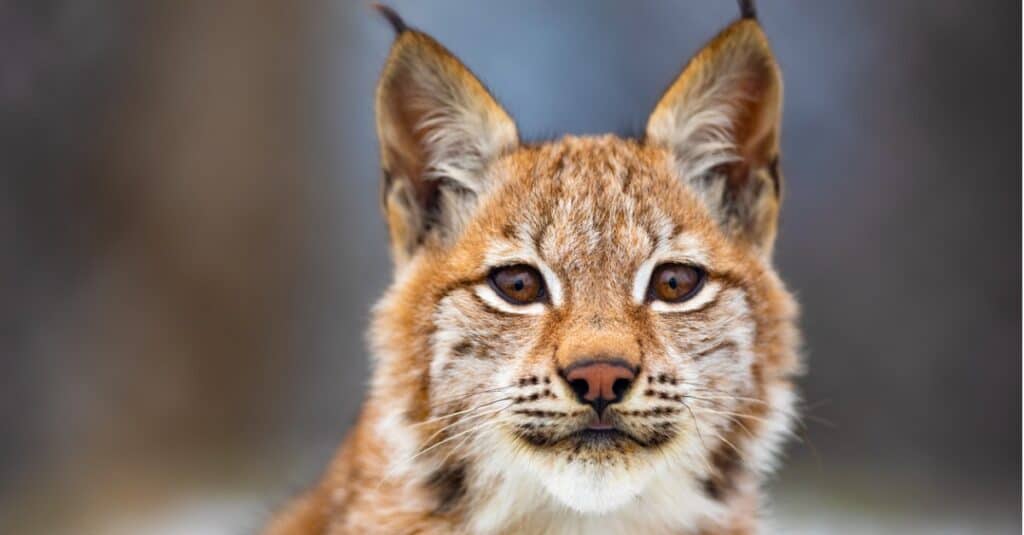
The Eurasian lynx is a solitary animal. They only live in groups during the mating season.
©iStock.com/kjekol
The Eurasian lynx is a solitary predator that does not bond in any significant sense with other members of the species; the only exception is perhaps the brief bond that forms between mother and kitten until independence. As a highly territorial species, a single lynx can easily maintain and defend a home range of more than 100 square miles. Males choose territories that give them access to several females in the breeding season. Females tend to choose territories with plenty of food to care for growing offspring; their territory tends to overlap with that of the male. As the number of prey increases, the lynx will tend to have smaller territories. When prey is scarce, the size of the territory likewise increases.
Unfortunately, we don’t know too many facts about how this species communicates. Except for the occasional growl or hiss, they tend not to vocalize very often or loudly except when encountering members of the same species. However, we do know that they prefer to mark their territory with urine or other secretions from their specialized glands.
The Eurasian lynx is most active in the morning and evening hours when it comes out to hunt for prey. The rest of the day is spent resting within thick brushes, tall grasses, and large trees. As one of the most agile predators in the world, the lynx is highly adept at running, swimming, and climbing. They can travel several miles in a single day in search of food to consume. When attempting to locate prey or potential mates, they rely on their excellent eyesight, night vision, and sense of hearing.
Habitat
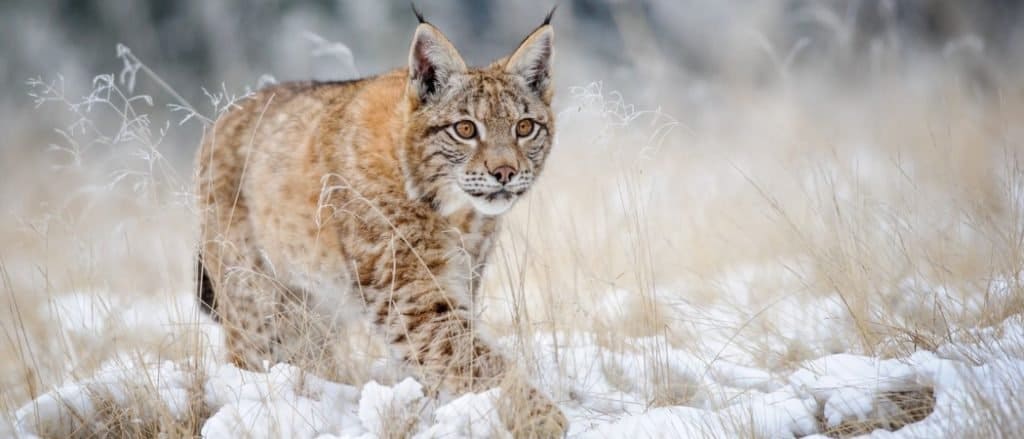
The Eurasian lynx prefers habitats with lots of trees and other vegetation in order to stalk its prey.
©iStock.com/sduben
The Eurasian lynx can be found in forests, mountains, and densely covered steppes across much of Eurasia. It prefers areas with heavy snowfall and plenty of cover to hide or stalk prey. These are difficult, hostile conditions up to an elevation of some 18,000 feet. Depending on where it’s located, there are several recognized subspecies, including the Siberian lynx, Balkan lynx, Carpathian lynx, and more.
Predators and Threats

The Eurasian lynx has historically been threatened by habitat loss, a reduction in prey, and poaching for its fur, which, because of its soft and silky texture, was often used to make clothing. The lynx is also sometimes killed by predators in the wild as well.
What Eats the Eurasian Lynx?
An adult lynx has few natural predators in the wild, but tigers, wolverines, and wolves have been known to prey on them directly or compete against them for resources. Kittens and juveniles are particularly vulnerable to predators. If threatened, the lynx may run away and hide in a tree. Height offers great protection.
What Does the Eurasian Lynx Eat?
This species is specially adapted to feed on hoofed mammals. Some of the most common prey items in its diet include roe deer, musk deer, and chamois. They will also sometimes target larger elk and caribou in the winter. Other possible prey includes rabbits, hares, red foxes, birds, and rodents. As solitary hunters, their primary strategy is to stalk and ambush the prey from cover. Upon pouncing, they will grab the prey by the neck or snout with their sharp teeth until it perishes. It’s estimated that they consume two to five pounds of meat every single day.
Reproduction and Life Cycle

Lynx cubs are born after a 70-day pregnancy.
©Stanislav Duben/Shutterstock.com
The Eurasian lynx mates every year between February and April. Females may only have a single mate per season; once she has copulated, her estrus period (or period of sexual availability) will immediately end. She is only in estrus for a few days every breeding season. If she loses her first litter of kittens, then she may enter a second period of estrus for the year. Males, on the other hand, will generally try to mate with as many females as they can. If the female is interested, then they will follow each other and copulate multiple times per day. The male will try to mate with all the females whose territories overlap with his own. He will also defend the territory from any male intruders.
After a gestation period that only lasts for about 70 days, the mother will give birth to a litter of up to five kittens at a time (although two or three is a more likely number) inside of a large den such as a hollow log or crevice lined with feathers, hair, and grass. Born blind and helpless with rather plain colors of gray and brown fur, they are completely dependent on the mother for food and protection. Fathers do not make a significant contribution to the care of the offspring. While they do begin to consume solid food around six or seven weeks later, the kittens aren’t fully weaned from the mother’s milk until they are about four or five months old. They gain full independence at around 10 months old and immediately leave to seek their own territory.
Females take about two years to become sexually mature and then reproduce at an interval of once every three years or so. Males may only achieve sexual maturity after about three years. Because juvenile mortality is so high, the typical lifespan for the lynx is only 17 years in the wild. If there are no significant threats, the lifespan is thought to be more like 24 years.
Population
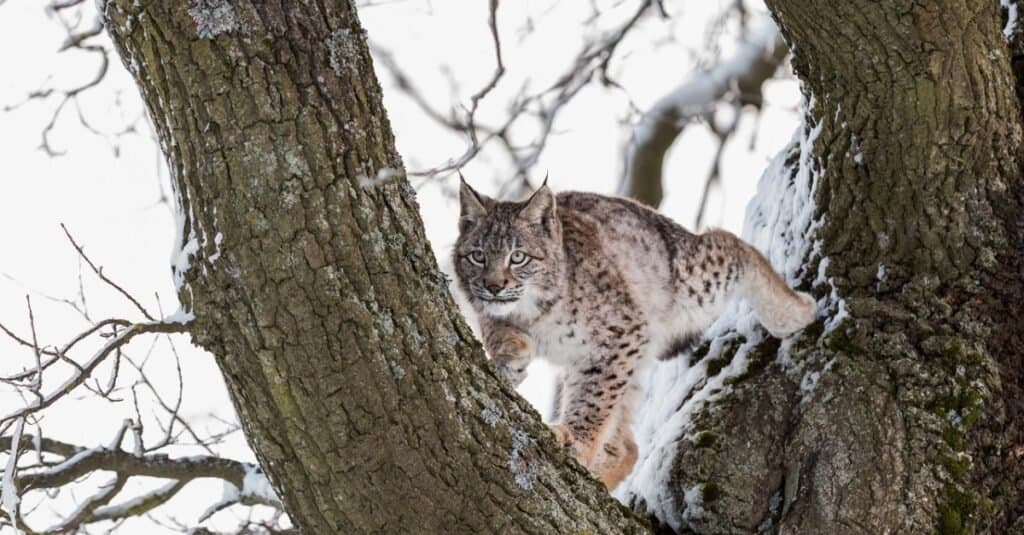
The Eurasian lynx has pointed, triangular ears that have black tuffs on the end.
©iStock.com/Murmakova
According to the IUCN Red List, the Eurasian lynx is considered to be a species of least concern, but that does not mean it is completely free of threats. In fact, the total population distribution is very uneven. The species is relatively safe and abundant in the remote habitats of northern Asia, the Himalayas, and other mountainous ranges, but for many centuries, its place in Europe was heavily threatened to the point of near extinction.
While the total number of lynxes is not known, there are thought to be as many as 10,000 individuals in Europe alone. Most of them are found in the Carpathian Mountains and the dense forests of Russia, but there are small, meaningful populations in many countries across Europe. Sometimes they cross borders on their own and establish new populations.
Because commercial hunting is now illegal in all countries except for Russia, population numbers appear to be increasing almost everywhere, particularly in the Balkans and Eastern Europe. Since the 1970s, it’s also been reintroduced to countries in Central and Western Europe, including France, Italy, and Germany. However, because of its immense territorial requirements, numbers are unlikely to reach their previous heights.
View all 117 animals that start with EEurasian Lynx FAQs (Frequently Asked Questions)
Is the Eurasian Lynx carnivorous, herbivorous, or omnivorous?
The Eurasian lynx is a carnivorous species. It feeds exclusively on animal meat.
Where do Eurasian lynx live?
This species can be found in cold areas of Eurasia with plenty of trees and rocks for cover. It has many adaptations to survive the cold, including thick fur, large paw pads, and camouflaged colors to help it blend in. These features should help with identification as well.
What do Eurasian lynx eat?
The Eurasian lynx feeds primarily on deer-like animals. If these are not available, then it may resort to foxes, hares, rabbits, birds, and rodents.
Are Eurasian lynx aggressive?
This species is not considered to be aggressive around humans. Unless directly provoked or threatened in some manner (especially in defense of their kittens), they would rather run away and hide.
Can you own a Eurasian lynx?
The lynx would be considered an exotic pet and subject to such laws in any country. However, because of their size and wild temperament, they would make for a very bad pet without specialized care that most people would not be able to provide. There are many other smaller wild or semi-wild cats that would make for better pets.
How many Eurasian lynxes are left?
The exact number is not known, but it is probably in the many tens of thousands in the wild. There are thought to be some 10,000 in Europe alone.
Why is the Eurasian lynx endangered?
The Eurasian lynx is actually not considered to be a threatened species across most of its natural range. One exception is the Balkan lynx subspecies. Found across Serbia and Macedonia, it was nearly driven to extinction from a combination of habitat loss and poaching. Populations further west also dwindled greatly after human contact and encroachment.
Do lynxes pur?
Yes, lynxes are thought to make a purring sound when contended.
Thank you for reading! Have some feedback for us? Contact the AZ Animals editorial team.
Sources
- Animal Diversity Web, Available here: https://animaldiversity.org/accounts/Lynx_lynx/

















